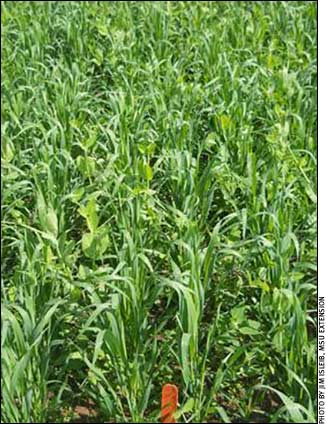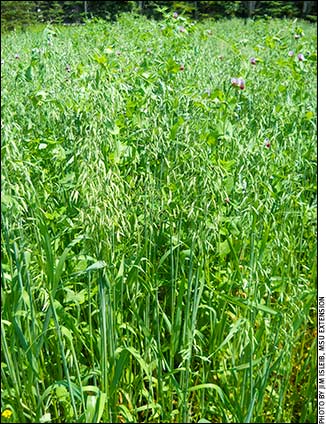When Should I Harvest My Small-grain Forage?
Decide what you need between yield and quality, then watch those small-grain forages closely to harvest them at the desired growth stage.

Oats and peas nurse crop on alfalfa. Seeding at 100 lb. per acre, 38 days after planting.
Farmers plant small-grain forages in two basic systems. One is as a nurse crop for a perennial hay crop such as alfalfa. A second is as a stand-alone annual forage crop. Harvest decisions depend largely on the system used. If the small-grain forage is a “nurse crop,” then the effects of the harvest decision are based on what is best for the perennial hay crop underneath. Leaving the nurse crop in place too long can create serious competition for the developing perennial hay crop.
Many farmers choose to remove the nurse crop as soon as the threat of erosion is past, with little regard for small-grain forage yield. The development of glyphosate-resistant alfalfa varieties makes this approach much more feasible. Others wait to remove the nurse crop until the small grain reaches early boot stage. This approach provides reasonable forage yield and quality, and removes the crop in time to allow the perennial hay a good start before it becomes dormant. Finally, some will wait until soft, or even hard, dough stage to maximize yield of small-grain forage. In this case, there is a stronger possibility that establishment of the perennial hay crop can be negatively affected.

Oats and peas alone as annual forage at 150 lb. per acre, 67 days after planting.
When small grains are planted for forage without a hay seeding, the decision is simpler. Former Michigan State University Extension Forage Specialist Doo-Hong Min had the following observations:
“In general, there are three stages of maturity for small grains — boot, milk and dough. The boot stage is the time when the head is enclosed by the sheath of the uppermost leaf. The milk stage is when the grain head releases a white liquid substance when opened. The dough stage is when the grain head begins to turn to a doughy consistency. As the plant matures from the boot stage to the dough stage, forage quality decreases while yield increases. If the goal is to harvest high-quality feed, then small grains for forage should be harvested in the flag leaf to boot stage. In contrast, if high yields are the goal, then harvest should occur in the late dough stage.
“If a compromise is desired, small grains should be harvested in the early dough stage,” Min adds. “If small-grain harvest is delayed past the late dough stage, then the forage may be too dry to ensile. Since small grains can progress from boot to dough stage in a relatively short period of time, they must be watched closely to harvest at your target time.”
University of Wisconsin Extension’s Pea and Small Grain Mixtures includes the following information from a 1980s three-year trial in Arlington, Wis., on oat/pea and barley/pea forage planted as alfalfa nurse crop (see Table 1).
The bottom line with small-grain forage crops is to know what you need in terms of yield, quality and impact on your new perennial hay crop … and watch closely!
| Table 1: Three-year trial on various forages planted as alfalfa nurse crop | ||||||
| Forage type |
Cut date |
Yield (lb./acre) |
Crude protein (%) |
NDF (%) |
Alfalfa yield during establishment year (lb./acre) |
Total 1st year forage yield (lb./acre) |
| Oats alone | June 12 | 3,201 | 13.5 | 52.9 | 1,915 | 5,135 |
| Oat/pea | June 12 | 3,441 | 17.6 | 46.3 | 1,770 | 5,191 |
| Barley alone | June 8 | 3,318 | 13.6 | 58.1 | 1,779 | 5,097 |
| Barley/pea | June 8 | 3,469 | 16.4 | 58.1 | 1,577 | 5,029 |

Editor’s Note: James Isleib is an MSU Extension educator in crop production and food and animal systems.






